Intel Details Manufacturing through 2023: 7nm, 7+, 7++, with Next Gen Packaging
by Ian Cutress & Anton Shilov on May 8, 2019 4:35 PM ESTAt Intel's Investor Day today, CEO Bob Swan and Murthy Renduchintala spoke to the ability of the company with respect to its manufacturing capabilities. Intel has historically been strong in its ability to execute on its process technology, however the delay of its 10nm process has obviously raised multiple question marks, and has done for several years. The two Intel executives went into a little detail about what Intel was doing in the interim, and how it has learned from the issues.
Back in 2013, Intel envisoned its 10nm to succeed the 14nm by providing 2.7x density, with new technologies such as Self-Aligned Quad Patterning (SAQP), Contact over Active Gate (COAG), Cobolt Interconnects, and new packaging technologies such as EMIB and Foveros. Intel admits that this was an ambitious plan, and the goals were not clearly defined with the teams and it was ultimately overly complex and not managed in an ideal way.
This ended up pushing 10nm out into a later time frame. In this case, Intel pushed 10nm out to 2019 (technically they shipped Cannon Lake in small quantities on 10nm in 2017, however that is nothing more than a curio in the timeline of semiconductors), and filled the gap with 14+ and 14++.
Intels 14+ and 14++ processes extracted more than 20% more performance (from Broadwell to Whiskey Lake) from the process since its inception. As a result, Intel is prepared to not only get ready for future intra-node optimizations, but actually adjust the roadmap to compensate for it. Murthy made it clear that Intel wants to introduce a Moore's Law-like gain at the beginning of a new process, and another similar gain by the end of the process.
Intel has stated that its 10nm product family (beyond Cannon Lake) will start to be available from the middle of this year (2019), with Ice Lake on client platforms (notebooks).
Intel will be launching multiple 10nm products through 2019 and 2020, including server based 10nm in the first half of 2020:
In the above slide, Intel states that it will have 7nm in production and launching a product in 2021. That sounds very aggressive for a company that has had issues with 10nm. It even shows in Intels radmap, with 10nm (and 10+ and 10++) having a much shorter life cycle than the 14nm family of processes.
With this in mind, Intel's 7nm is going to be the combination of what Intel has learned from the 14nm and 10nm family of products. Intel wants that 2x scaling (Moores Law), but with intra-node optimations planned as part of the roadmap. Intel is also reducing its number of design rules, which should help with execution. 7nm will also be where Intel intersects with EUV, and also introduce next-gen Foveros and EMIB packainging.
Intel provided this slide, which shows a monolithic PC-Centric die with a multi-die Data-Centric chip built on both Foveros and EMIB. This corroborates our discussion with Intel's chiplet and packaging team, who also stated that we would see Foveros and EMIB on a combined product - specifically the GPU.
Intel announced that its lead 7nm product (lead = top, or lead = first?) would be its new GPGPU, built on the Xe graphics architecture. Intel has stated that its Xe product stack will feature two different microarchitectures from mobile client up to GPGPU, with one of those architectures called Arctic Sound - technically Intel will launch its first discrete GPU in 2020 according to its press release, however the 7nm GPGPU will be launched in 2021.
More information is coming out of Intel's Event, more to follow.
Related Reading
- Intel: EUV-Enabled 7nm Process Tech is on Track
- Intel Starts Qualification of Ice Lake CPUs, Raises 10nm Volume Expectation for 2019
- Intel Agilex: 10nm FPGAs with PCIe 5.0, DDR5, and CXL
- Intel to Equip Fab 42 for 7 nm
- Intel Discloses Plans to Spend $5 Billion on Fab 28 Expansion in Israel
- Intel Submits Ireland Fab Expansion Plan: $8 Billion Price Tag, With a 4 Year Lead Time
- Intel Details Plans for Its Oregon Fab Expansion: D1X Phase 3
- Intel to Expand Production Capacities at Multiple Fabs
Source: Intel


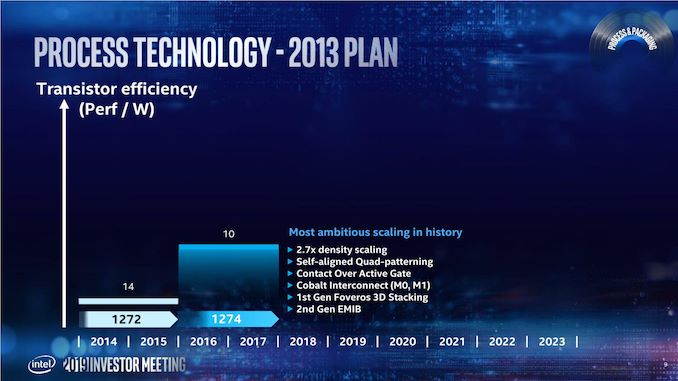

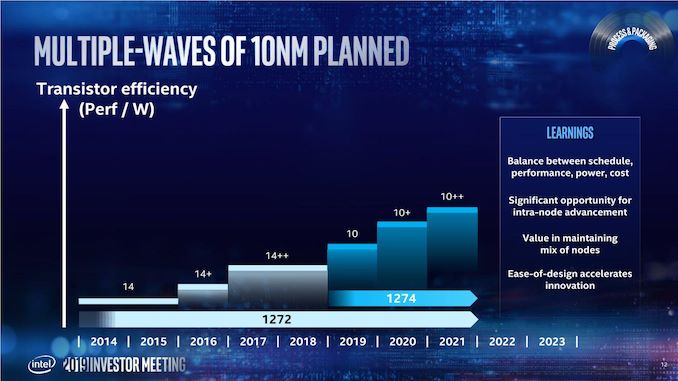
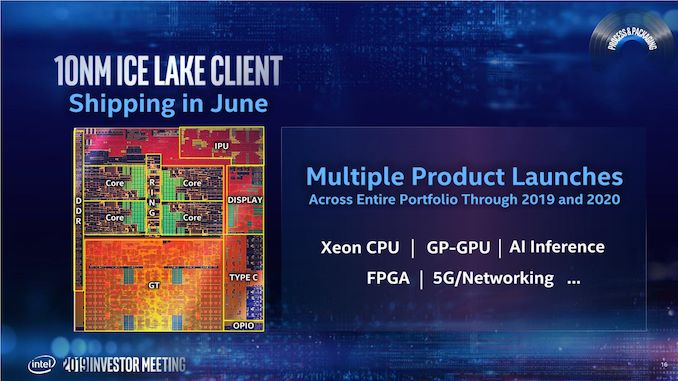
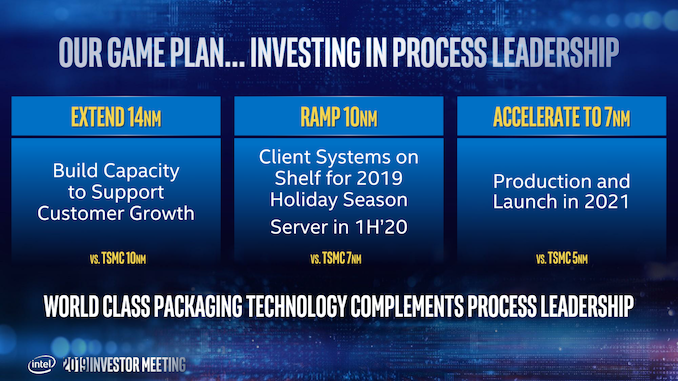
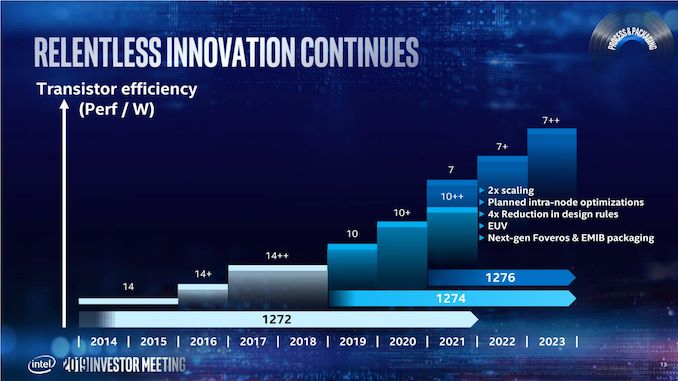

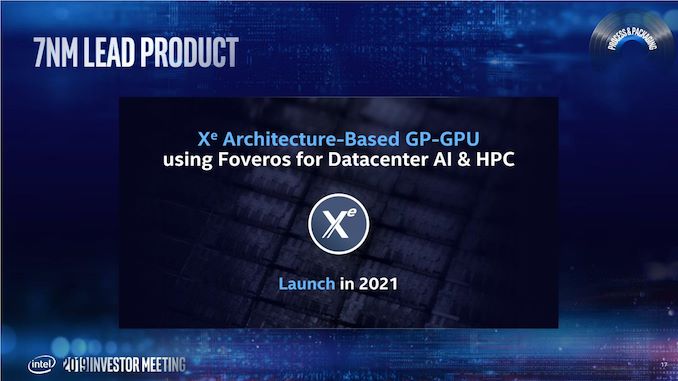








237 Comments
View All Comments
crotach - Thursday, May 9, 2019 - link
It's missing 14+++, 14++++ and 14+++++ on the roadmap!Nimrael - Thursday, May 9, 2019 - link
You have your brain missed too...HStewart - Thursday, May 9, 2019 - link
14 series is going away with this stuff. But intel's packaging allows it to be IO and such.Irata - Thursday, May 9, 2019 - link
I think what many are forgetting is that regardless of which process comes out when, one of Intel's big advantages was being ahead as far as processes are concerned, sometimes two nodes ahead of the competition. This did give them a lot of headroom over the competition as far as power consumption, clock speed and (space for) features was concerned.Even right now, they are still ahead of AMD process wise, but when AMD moves to TSMC 7nm with their main CPU, this is the first time in a long time that Intel is behind.
Even if / when they catch up, they will be going up against the competition using comparable processes.
shompa - Thursday, May 9, 2019 - link
One of the main reasons why Intel will get more chips available is because Apple will start to switch to ARM. That frees up almost 10% of Intel's capacity.And the real reason for Intel's CPU constraints the last year is that 10nm has not come online and there was no more 14nm fab space. To "compete" Intel doubled the cores on mainstream chips/servers = they can produce 50% fewer chips. It's that easy, but fanboys think that Intel somehow sells more chips even if fewer X86 overall are sold. Add to that AMD that also will take 20% market share from Intel.
RSAUser - Thursday, May 9, 2019 - link
I doubt Apple will "switch to ARM" any time soon. They might for the next generation or two add an ARM chip for low performance stuff (e.g. the touch bar they did it for), but they can't make it exclusive yet.peevee - Thursday, May 9, 2019 - link
They can. Their high-performance cores in A12 are very impressive and almost a year old, for a laptop/desktop chip they can have more of them and clocked higher - and next gen.All they really need is a good x64 to ARM v8.2 (8.3 for next core?) compiler, which is much much harder to do compared to their experience with Power to x86 as modern x64 with AVX2 is extremely more complex instruction set. I bet they are secretly working on it for a few years now though.
Targon - Friday, May 10, 2019 - link
You give up software compatibility in the switch from Intel to ARM based chips. If Apple were to do that, those who actually use their computers for more than web browsing and e-mail would drop Apple at that point. It was a huge issue when Apple made the jump to Intel, and when Apple switched from MacOS 9 to MacOS X due to software incompatibility.peevee - Wednesday, May 22, 2019 - link
"You give up software compatibility in the switch from Intel to ARM based chips."Nope. Read what I wrote. Read up on their transition from Moto 680xx to PowerPC, from PowerPC to x86. Same thing applies here, just a good binary code compiler.
Daeros - Thursday, May 9, 2019 - link
Why not? They have the performance already from an in-house design:https://www.tomsguide.com/us/new-ipad-pro-benchmar...